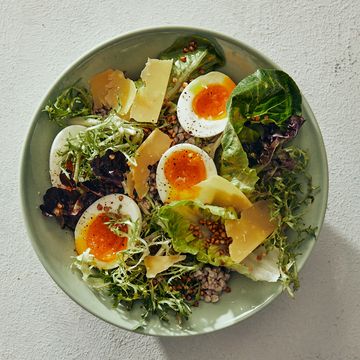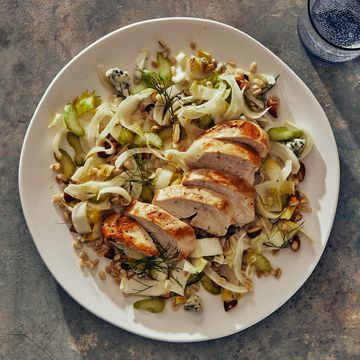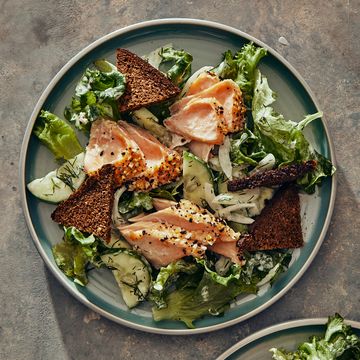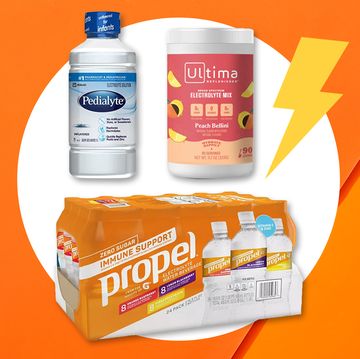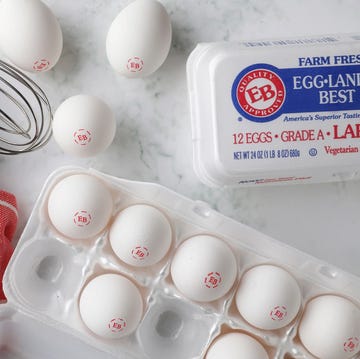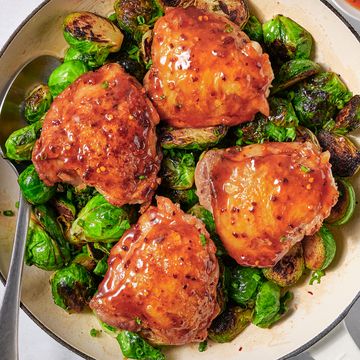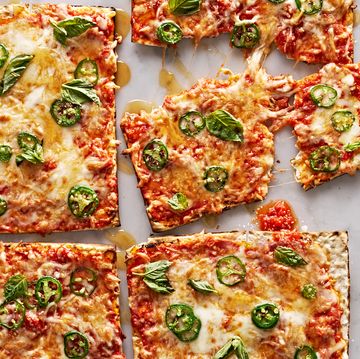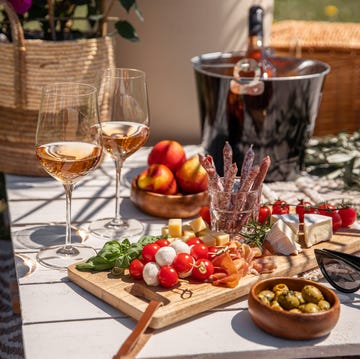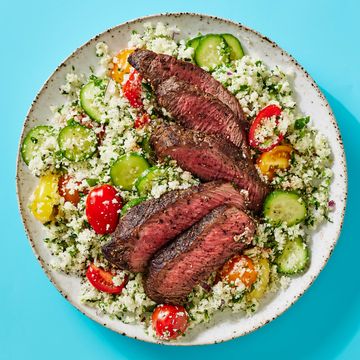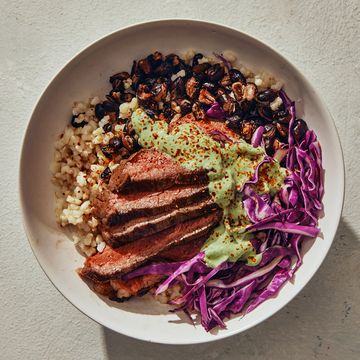This article was written by the editors of Well+Good and repurposed with the site's permission.
Our wellness predictions are in, and these are the top healthy food trends we'll all be talking about in the year ahead.
1. Everyone Will Be Eating Breakfast, Lunch, and Dinner Out of a Bowl
It all started with smoothie bowls. You know, the ridiculously photogenic ones that populate your Instagram feed every morning? But now bowls are branching out to claim lunch and dinner, too, and they’re making a savory appearance on healthy-leaning restaurant menus, going by the name of grain bowls, macro bowls, veggie bowls, poke (sushi-style) bowls, and more. There’s even a cookbook called Bowl coming out by foodie-author Lukas Volger this year.
While many point west to the trend’s origin—with Cafe Gratitude serving as the Cali-style veggie bowl patron saint—it’s now a cross-country phenomenon, with many of the buzziest new eateries (in New York City alone, there’s Dimes, By Chloe, and Inday, among many others) attracting a stylish clientele eager to dig into their single-vessel offerings. And even fast-food has caught on: Sweetgreen’s rapid ascent to the healthy cool kid’s lunch table has happened with a bowl in hand, and Los Angeles’ Edibol created an entire good-for-you grab-and-go restaurant around the concept.
But there may be more than just tastebuds directing this trend. Some say that portion control is behind the bowl, that it’s a great way to get your protein, grains, and veggies, in perfect proportions. Others say that this is just the healthy, casual way more Americans want to be eating right now. “There’s something really comforting about the serving vessel,” says Volger. “There’s something nice about the whole meal being there.”
2. Seaweed Will be the New Kale
Suddenly, everyone is talking about the not-so-sexy underwater plant, for its nutrient profile, skin-care benefits, and incredible potential for combatting climate change (as recently detailed in The New Yorker, which called it “a miracle food”). “Seaweeds are amongst the most nutrient-dense plants on the planet, and as they have access to all the nutrients in the sea, they are an extremely rich source of minerals,” explains Scotland’s Mara Seaweed CEO and co-founder Fiona Houston. Houston says an array of Michelin-starred chefs are now cooking with her products, and “manufacturers are using seaweed as a healthy option to replacing the salt added to processed foods,” adds Jane McKenzie, Ph.D., a food and nutrition expert at Queen Margaret University.
Repechage founder Lydia Sarfati was one of the first to bring high-quality seaweed harvested off the coasts of France and Maine to skincare in the U.S. and says she’s seen its popularity growing recently, which doesn’t surprise her. “The bioactive substances derived from seaweed provide a beneficial and functional role at the cellular level, contributing to healthy looking skin, hair, and nails,” she says. Sushi joints are going to have to give up their monopoly—soon we’ll all be making both salads and face masks with kombu.
3. Matcha Everything
Matcha (a Japanese green tea that’s in powder form and is whisked into hot water or milk) is becoming a trendy new staple in pretty much any coffee shop you go to (yup, even Starbucks), and more and more brands from Teavana to T2 are making at-home versions of the lightly caffeinated beverage as well. “We experienced double-digit sales growth last year of our Organic Imperial Grade Matcha,” says Teavana director of tea development Naoko Tsunoda. As a result, the company just launched single-serving organic matcha.
And it’s not just for drinks. Trendy hotspots in New York City like Victory Garden, Juice Generation, and Lafayette love adding matcha to desserts and brunch menus. With this kind of enthusiasm for the tea, we could see more matcha-dedicated cafes pop up around the country to join MatchaBar in New York City and Matcha Box in Los Angeles. And we wouldn’t be surprised if the antioxidant-rich green tea started to show up in beauty products or if matcha machines soon occupied a place next to your Nespresso in 2016. (In fact, Sharp just released an instant matcha maker…)
4. Meet Adaptogens, the New Stress-Fighting Superherbs
You’ve heard of superfoods. Well, meet the superherbs. Some plants have superpowers that can help the body adapt to stress and handle it in a healthy way (versus making us run down and feel exhausted). These wonders are called adaptogens, and they have the attention of physicians like Frank Lipman, M.D., and juice mavens (Lianna Sugarman to Amanda Chantal Bacon) to skin-care brands (Juara). They’re excited about the potential of these stress-fighting superherbs to improve all kind of issues related to health and beauty.
“They help your body adapt to its specific needs,” says Lipman, who has long been prescribing adaptogenic herbs to his patients. “No food can do that, [and] I don’t know any other herbs that work that way.” So this year you’ll start to see adaptogenic ingredients like moringa, Ashwagandha, maca, and Ginseng in your juices, healthy food items (including chocolate), beauty products, and more. “As we burn out on big pharma drug experiments and look to sustainable sources to help with stress and health, all arrows point to these herbs—and they truly work,” says Bacon, who stocks her juice bars with these herbs in smoothie-friendly forms. “Once you experience the effects, you will never go back.”
5. Nut Milks Will Go Bespoke and Small-Batch
You could say nut milks are now getting the attention that cold-pressed juices were getting seven years ago. More people are drinking nut and seed milks than ever before, thanks to all the exposure around dairy intolerance and the bad press surrounding soy. People now want milks that are all-natural and emulsifier-free (2015 was not a kind year to carrageenan). Customers are looking at ingredients, says Elly Truesdell, the local brand buyer for Whole Foods’ Northeast region, and they’re putting down the milk cartons. “As better milk alternatives have been made—that are refrigerated and not shelf-stable, and are free of certain ingredients—people are starting to choose those.”
These newer bespoke brands like OMilk are thinking outside of the shell with inventive flavor combos and milks made with cashew, walnut, macadamia nut, Brazil nut, even pistachio. Beyond the supermarket, many cafes are making their own nut milks, with Yelp reviewers praising the creamy homemade offerings at Sqirl, Go Get Em Tiger, and other healthy Los Angeles spots. And for a taste of milk-man nostalgia, outfits like NotMilk and Can Can Nut Milk deliver small batch nut milks to your door. “We’ve quadrupled our production in the last six months,” says Carolyn Flood, the co-founder of NotMilk who—along with her sister Susan—personally drops off the handcrafted blends. “It’s kind of like store-bought orange juice versus fresh-squeezed. It’s just worlds apart.”
For more 2016 trend predictions in health, fitness, and wellness, head on over to Well+Good!



